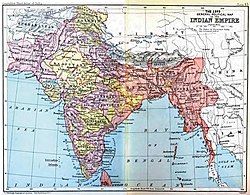The Raj
|
||||||||||||||||||||||
| Imperial political structure comprising (a) British India (a quasi-federation of presidencies and provinces directly governed by the British Crown through the Viceroy and Governor-General of India); (b) Princely states, governed by Indian rulers, under the suzerainty of the British Crown exercised through the Viceroy and Governor-General of India |
||||||||||||||||||||||
|
||||||||||||||||||||||
|
|
||||||||||||||||||||||
|
Anthem God Save the King/Queen |
||||||||||||||||||||||
|
The British Indian Empire in 1936
|
||||||||||||||||||||||
| Capital | ||||||||||||||||||||||
| Languages | (official, Urdu from 1857. Hindi from 1900) | |||||||||||||||||||||
| Government | Colony | |||||||||||||||||||||
| Monarch of the United Kingdom and Emperor/Empressa | ||||||||||||||||||||||
| • | 1858–1901 | Victoria | ||||||||||||||||||||
| • | 1901–1910 | Edward VII | ||||||||||||||||||||
| • | 1910–1936 | George V | ||||||||||||||||||||
| • | 1936 | Edward VIII | ||||||||||||||||||||
| • | 1936–1947 | George VI | ||||||||||||||||||||
| Viceroy and Governor-Generalc | ||||||||||||||||||||||
| • | 1858–1862 | (first) Charles Canning | ||||||||||||||||||||
| • | 1947 | (last) Louis Mountbatten | ||||||||||||||||||||
| Secretary of State | ||||||||||||||||||||||
| • | 1858–1859 | (first) Edward Stanley | ||||||||||||||||||||
| • | 1947 | (last) William Hare | ||||||||||||||||||||
| Legislature | ||||||||||||||||||||||
| History | ||||||||||||||||||||||
| • | Battle of Plassey & Indian Rebellion | 23 June 1757 & 10 May 1857 | ||||||||||||||||||||
| • | Government of India Act | 2 August 1858 | ||||||||||||||||||||
| • | Indian Independence Act | 15 August 1947 | ||||||||||||||||||||
| • | Partition of India | 15 August 1947 | ||||||||||||||||||||
| Currency | Indian rupee | |||||||||||||||||||||
|
||||||||||||||||||||||
| Today part of |
|
|||||||||||||||||||||
| a. | Title existed 1876–1948 | |||||||||||||||||||||
| c. | Full title was "Viceroy and Governor-General of India" | |||||||||||||||||||||

Imperial entities of India
|
|
| Dutch India | 1605–1825 |
|---|---|
| Danish India | 1620–1869 |
| French India | 1668–1954 |
|
|
|
| Casa da Índia | 1434–1833 |
| Portuguese East India Company | 1628–1633 |
|
|
|
| East India Company | 1612–1757 |
| Company rule in India | 1757–1858 |
| British Raj | 1858–1947 |
| British rule in Burma | 1824–1948 |
| Princely states | 1721–1949 |
| Partition of India |
1947
|
|
|
|
The British Raj (/rɑːdʒ/; from rāj, literally, "rule" in Hindustani) was the rule by the British Crown in the Indian subcontinent between 1858 and 1947. The rule is also called Crown rule in India, or direct rule in India. The region under British control was commonly called India in contemporaneous usage, and included areas directly administered by the United Kingdom, which were collectively called British India, and those ruled by indigenous rulers, but under British tutelage or paramountcy, and called the princely states. The de facto political amalgamation was also called the Indian Empire and after 1876 issued passports under that name. As India, it was a founding member of the League of Nations, a participating nation in the Summer Olympics in 1900, 1920, 1928, 1932, and 1936, and a founding member of the United Nations in San Francisco in 1945.
...
Wikipedia




